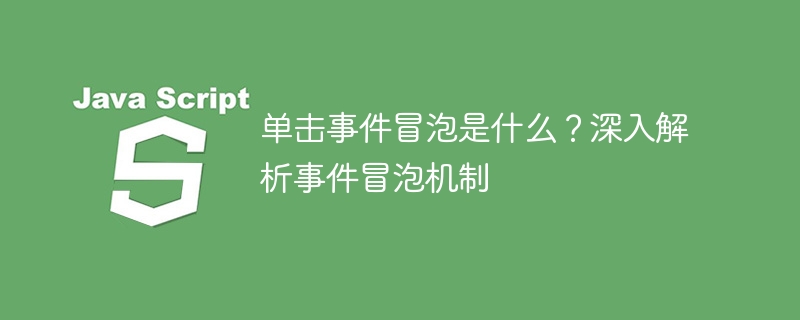

What is click event bubbling? In-depth analysis of the event bubbling mechanism requires specific code examples
Event bubbling (Event Bubbling) means that in the DOM tree structure, when an element triggers an event, the event will flow along the DOM tree from the child The element is passed all the way to the root element. This process is like bubble bubbling, so it is called event bubbling.
Event bubbling is a mechanism of the DOM event model, included in documents such as HTML, XML and SVG. This mechanism allows event handlers registered on a parent element to receive events triggered by its child elements. Event bubbling makes event processing more flexible and convenient.
In order to better understand the event bubbling mechanism, let's look at a specific example. Let's say we have an HTML page that has a div element and a button element nested within it. We registered a handler for the click event on the div element. When we click the button, the div's click event handler is also fired.
<!DOCTYPE html>
<html>
<head>
<script>
window.onload = function(){
var div = document.getElementById("myDiv");
var button = document.getElementById("myButton");
button.addEventListener("click", function(event){
alert("Button Clicked!");
event.stopPropagation(); // 阻止事件继续向上冒泡
});
div.addEventListener("click", function(){
alert("Div Clicked!");
});
};
</script>
</head>
<body>
<div id="myDiv">
<button id="myButton">Click Me</button>
</div>
</body>
</html>In the above example, we registered click event handlers for the button element and div element respectively through the addEventListener method. When we click the button, the button's click event handler will be triggered first, and then the div's click event handler will be triggered.
If we do not want the event to continue to bubble up, we can call the event.stopPropagation() method in the event handler. Modify the above code, add the event.stopPropagation() method to the button's click event handler, and then run it again. We will find that when the button is clicked, only the button's click event handler is triggered, and the div's click event The handler was not triggered.
In addition to event bubbling, there is another event delivery mechanism called event capturing. Starting from the root element, the event handler of the root element is triggered first, and then the events of the child elements are triggered in turn. handler. The event capture mechanism is a complement to the event bubbling mechanism, and together they constitute the event flow (Event Flow).
In short, event bubbling means that events are passed from child elements to parent elements, while event capture is the reverse order, starting from parent elements and passed to child elements.
In actual development, understanding the event bubbling mechanism can help us handle events better and improve the performance of the program. By rationally utilizing the event bubbling mechanism, we can reduce duplicate event processing code and improve the maintainability of the code.
To sum up, event bubbling is a DOM event delivery mechanism. When processing an event, the event will be passed from the triggering element to the ancestor element step by step. This process is just like bubble bubbling. Understanding and flexibly applying the event bubbling mechanism can improve our code efficiency and development experience.
The above is the detailed content of Analysis of event bubbling mechanism: What is click event bubbling?. For more information, please follow other related articles on the PHP Chinese website!




